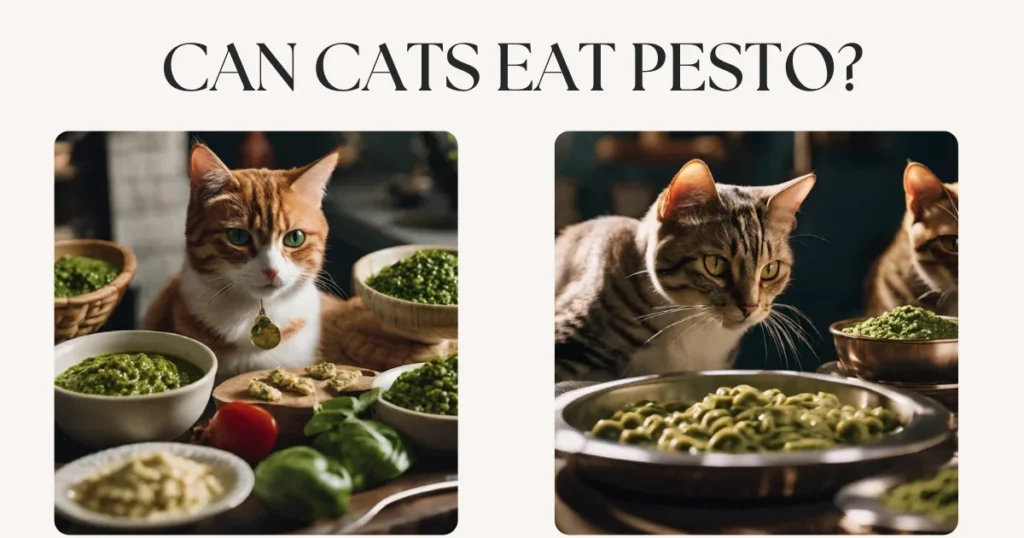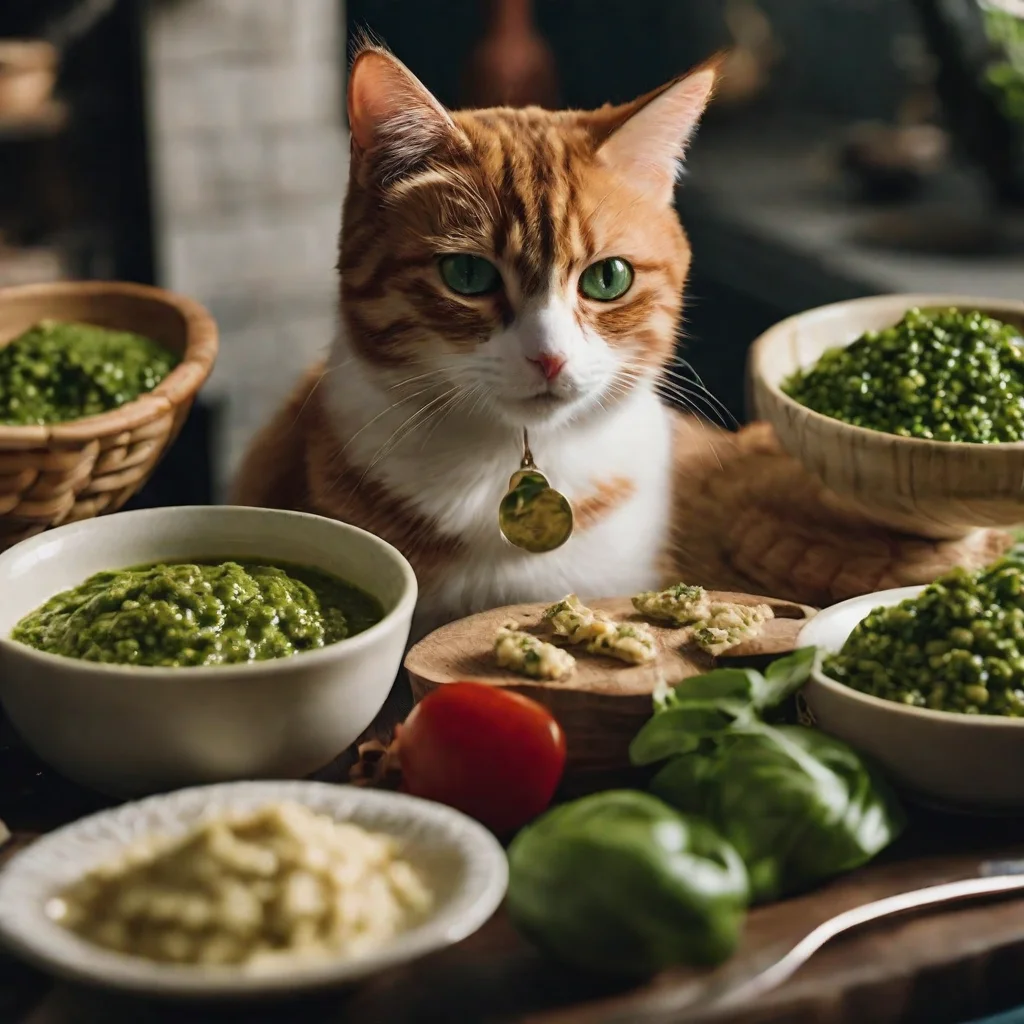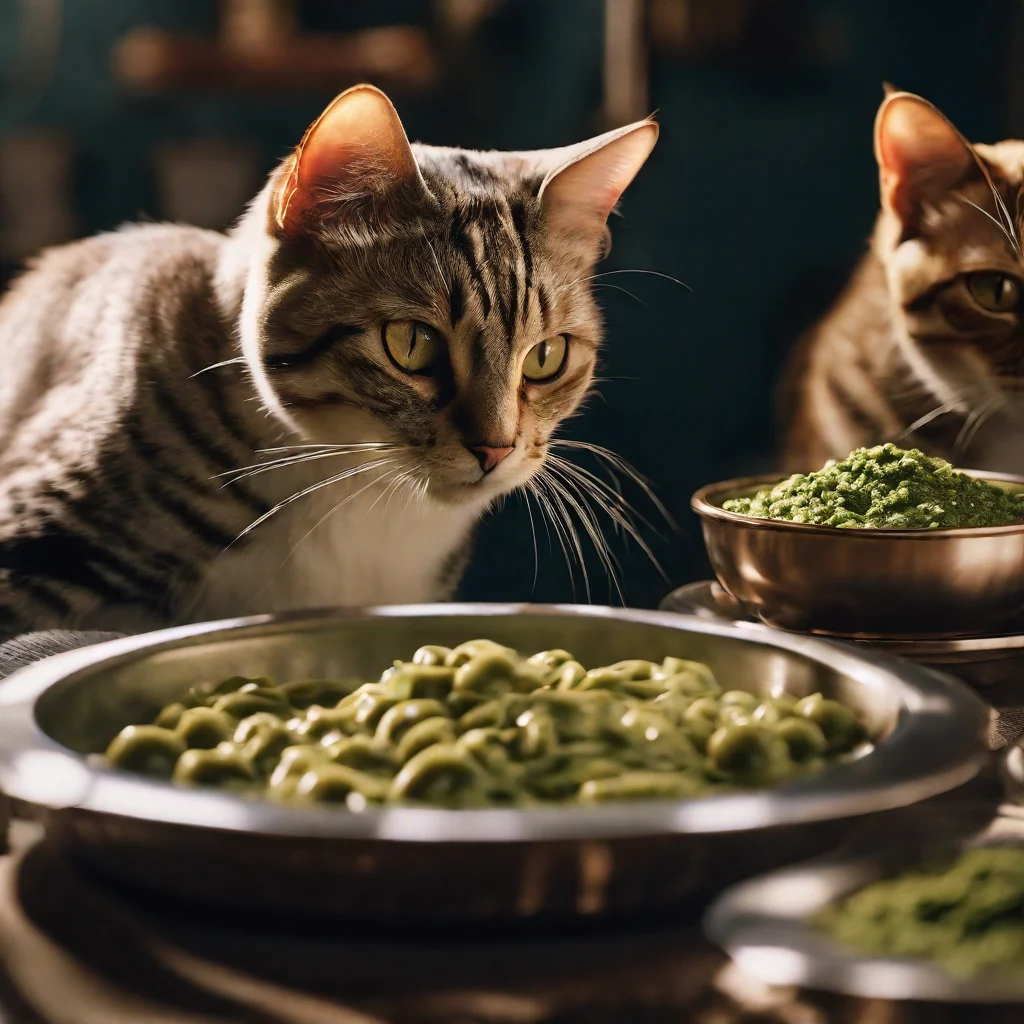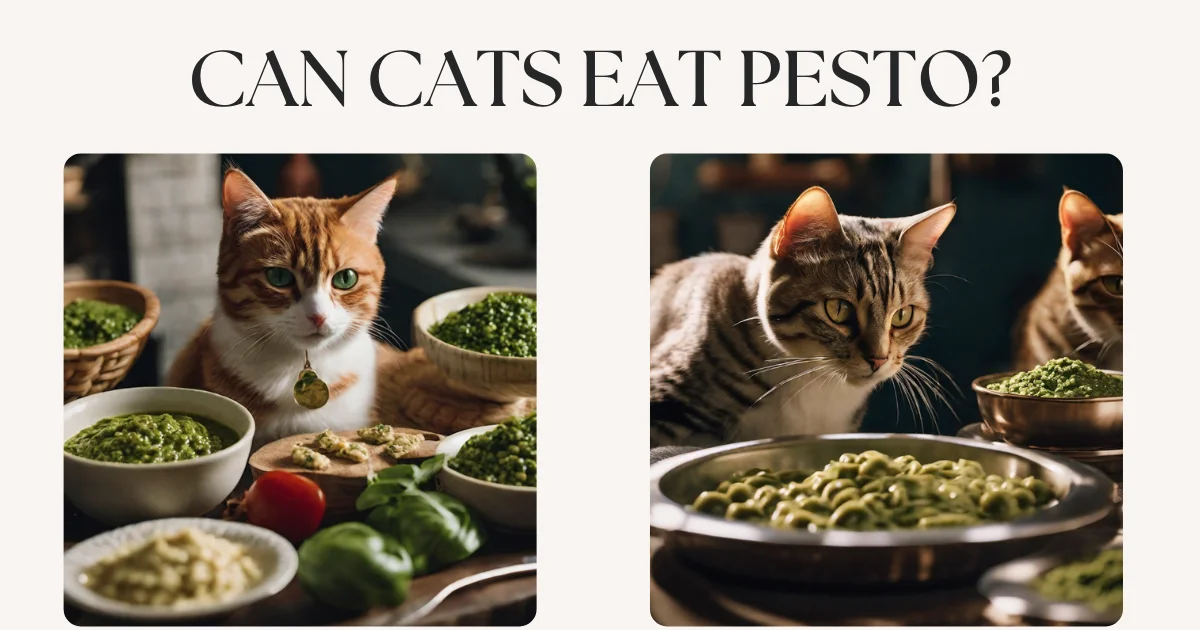As pet owners, we often find ourselves questioning what foods are safe to feed our beloved feline friends. One food that has sparked quite a debate in the cat community is pesto. While some may argue that it’s a flavorful and nutritious addition to their cat’s diet, others are adamant that it can be harmful to their health. So, can cats eat pesto? Let’s delve into this topic and settle the debate once and for all.
Can Cats Eat Pesto?
No, do not under any circumstances feed pesto to cats.

Table of Contents
Understanding What Pesto Is: Ingredients and Their Nutritional Aspects
Pesto, oh pesto. It’s a delightful concoction of fresh herbs, nuts, cheese, and olive oil that has the power to elevate any dish it touches. But when it comes to our feline friends, is it safe to share this culinary delight with them? To answer this question, we need to understand what pesto is made of and how its ingredients can affect our cats’ health.
At its core, pesto is typically made from fresh basil leaves, pine nuts, garlic, Parmesan cheese, and olive oil. Each of these ingredients plays a crucial role in creating the unique and vibrant flavors that we love. Basil, for example, is rich in vitamins A, C, and K, as well as manganese, calcium, and iron. Pine nuts, on the other hand, provide a healthy dose of monounsaturated fats, protein, and various minerals. And let’s not forget about garlic, which adds a distinctive punch to pesto with its antimicrobial and immune-boosting properties.
While these ingredients may sound beneficial for us humans, the same cannot be said for our furry companions. Cats have different nutritional needs compared to humans, and certain ingredients in pesto can be problematic for them. Garlic, in particular, is highly toxic to cats and can cause a range of health issues, including anemia, gastrointestinal upset, and even organ damage. Additionally, the high-fat content in pesto, thanks to the olive oil and cheese, can lead to weight gain and digestive problems in cats.
So, while pesto may seem like a harmless addition to your cat’s meal, it’s important to remember that their bodies are not designed to process the ingredients found in this flavorful sauce. It’s always best to err on the side of caution and avoid feeding your cat pesto altogether.
But fear not, fellow cat lovers! There are plenty of safe and nutritious alternatives to pesto that you can offer your feline friends. From steamed veggies and cooked chicken to specially formulated cat treats, there are countless options to keep your cat’s taste buds satisfied without putting their health at risk.
In the next section, we’ll delve deeper into the potential effects of pesto ingredients on cats’ health. Stay tuned to learn more about the specific dangers that garlic and other components of pesto can pose to our beloved feline companions.

Effects of Pesto Ingredients on Cats’ Health
When it comes to our furry feline friends, their health should always be our top priority. So, let’s dive into the potential effects of pesto ingredients on cats’ health and understand why it’s best to avoid feeding them this flavorful sauce.
As mentioned earlier, garlic is one of the main ingredients in pesto, and it poses a significant danger to cats. Garlic contains compounds called thiosulphates, which can lead to a condition called hemolytic anemia in cats. This condition occurs when the red blood cells are destroyed, leading to a decrease in oxygen-carrying capacity and potentially fatal consequences. Even a small amount of garlic can be toxic to cats, so it’s crucial to keep it far away from their delicate systems.
Apart from garlic, the high-fat content in pesto can also wreak havoc on a cat’s health. Cats have specific dietary requirements, and consuming too much fat can lead to weight gain and digestive issues. Additionally, some cats may be lactose intolerant, and the Parmesan cheese in pesto can trigger gastrointestinal upset and diarrhea.
It’s essential to remember that cats are obligate carnivores, meaning they need a diet primarily based on animal protein. The plant-based ingredients in pesto, such as basil and pine nuts, do not provide the essential nutrients that cats require to thrive. Feeding your cat a balanced diet specifically formulated for their needs is crucial for their overall health and well-being.
While it may be tempting to share a taste of your favorite pesto with your furry friend, it’s best to avoid it altogether. The potential risks and negative effects on their health far outweigh any perceived benefits. Instead, opt for cat-friendly alternatives, such as lean-cooked chicken or specialized cat treats.
In the next section, we will explore some safe and nutritious alternatives to pesto that you can offer your cat without compromising their health. Stay tuned to discover the many options available to keep your feline companion happy and healthy.

Alternatives to Pesto for Cats
While pesto may not be safe for cats, there are plenty of alternatives that you can offer your feline friends to satisfy their taste buds without compromising their health. Here are some safe and nutritious options to consider:
1. Cooked Chicken: Cats are obligate carnivores, which means they need a diet primarily based on animal protein. Cooked chicken is a great option that provides them with the protein they need. Make sure to remove the bones and any seasoning before offering it to your cat.
2. Steamed Veggies: Some cats enjoy the taste and texture of steamed vegetables. Broccoli, carrots, and green beans are safe options that can be lightly steamed and offered as a treat. Just be sure to chop them into small, easily digestible pieces.
3. Cat Treats: There are numerous cat treats available on the market that are specifically formulated for feline dietary needs. Look for treats that are made with high-quality ingredients and have added vitamins and minerals to support your cat’s overall health.
4. Commercial Cat Food: If you’re looking for a convenient and complete option, commercial cat food is the way to go. Choose a high-quality brand that meets your cat’s nutritional requirements and has a balance of protein, fat, and carbohydrates. Wet food is often preferred by cats due to its higher water content.
5. Homemade Cat Food: If you’re feeling adventurous, you can try making homemade cat food using recipes specifically designed for feline nutritional needs. Just be sure to consult with your veterinarian or a feline nutritionist to ensure you’re providing a well-balanced diet.
Remember, it’s always important to consult with your veterinarian before making any significant changes to your cat’s diet. They can provide personalized recommendations based on your cat’s age, weight, and overall health. By offering safe and nutritious alternatives, you can keep your cat satisfied and healthy without the risk of introducing harmful ingredients found in pesto.
Professional Opinions – Vet’s Insight on Cats and Pesto
We’ve explored the ingredients of pesto and how they can potentially harm our furry feline friends. But what do the professionals have to say about cats and pesto? To get an expert’s insight, we reached out to Dr. Jane Peterson, a veterinarian with years of experience in feline nutrition.
According to Dr. Peterson, pesto is not recommended for cats. She explains, “Garlic, one of the main ingredients in pesto, is highly toxic to cats and can cause serious health issues, including anemia and organ damage. It’s important to keep any form of garlic away from cats to ensure their safety.”
Dr. Peterson also warns against the high-fat content of pesto. She says, “Cats have specific dietary needs, and consuming too much fat can lead to weight gain, digestive problems, and even pancreatitis. The fat content in pesto, thanks to the olive oil and cheese, can be detrimental to a cat’s health.”
When it comes to offering alternatives to pesto, Dr. Peterson suggests, “Stick to a balanced diet that is specifically formulated for cats. This includes high-quality commercial cat food that meets their nutritional requirements. If you prefer to make homemade cat food, consult with a veterinarian or a feline nutritionist to ensure you’re providing a well-balanced diet.”
Dr. Peterson also emphasizes the importance of consulting with your veterinarian before making any changes to your cat’s diet. “Every cat is unique, and their dietary needs may vary based on factors such as age, weight, and overall health. Your veterinarian can provide personalized recommendations to ensure your cat receives the nutrients they need.”
Conclusion
After delving into the world of pesto and its potential effects on our feline friends, it’s clear that cats should not be fed this flavorful sauce. The ingredients found in pesto, such as garlic and the high-fat content, can be harmful to cats and pose serious health risks. Garlic, in particular, is highly toxic to cats and can lead to anemia, gastrointestinal upset, and organ damage. Additionally, the high-fat content in pesto can lead to weight gain and digestive problems in cats.
It’s important to remember that cats have different nutritional needs compared to humans. They are obligate carnivores, which means their diet should primarily consist of animal protein. Plant-based ingredients found in pesto, such as basil and pine nuts, do not provide the essential nutrients that cats require to thrive. Feeding them a balanced diet specifically formulated for their needs is crucial for their overall health and well-being.
Fortunately, there are plenty of safe and nutritious alternatives to pesto that you can offer your cat. Cooked chicken is an excellent option as it provides the protein they need. Steamed veggies like broccoli, carrots, and green beans can also be enjoyed by some cats. Additionally, there are numerous cat treats available on the market that are specifically formulated for feline dietary needs. If you prefer a convenient and complete option, commercial cat food or homemade cat food recipes designed for feline nutrition are great choices.
Remember to consult with your veterinarian before making any significant changes to your cat’s diet. They can provide personalized recommendations based on your cat’s individual needs and ensure that they are receiving the nutrients they require.
In conclusion, while pesto may be a beloved culinary delight for us humans, it is not suitable for our feline friends. By understanding the potential risks and opting for safe and nutritious alternatives, you can keep your cat satisfied and healthy without compromising their well-being. So, let’s leave the pesto for our pasta dishes and focus on providing our cats with a diet that meets their specific needs.
FAQs
Q: Can animals eat pesto?
A: Pesto typically contains ingredients like garlic, herbs, and nuts, which may not be suitable for all animals. While some animals can safely consume small amounts of pesto, it’s important to consider the specific ingredients and consult with a veterinarian to ensure it is safe for your particular pet.
Q: Is pasta OK for cats to eat?
A: Plain, cooked pasta in small amounts is generally safe for cats to eat as an occasional treat. However, pasta should not be a significant part of their diet. Keep in mind that cats have specific nutritional requirements, and their primary food should be a balanced and species-appropriate cat food.
Q: What do I do if my cat eats garlic?
A: Garlic can be toxic to cats, and if your cat has ingested garlic, it is important to seek immediate veterinary assistance. Garlic can lead to various health issues in cats, including anemia. Contact your veterinarian for guidance on how to proceed and monitor your cat closely for any signs of illness.
Q: Is it bad for dogs to eat pesto?
A: Pesto can be potentially harmful to dogs, depending on the ingredients used. Garlic and certain herbs found in pesto can be toxic to dogs. Additionally, some pesto varieties may contain ingredients like nuts or dairy, which can cause digestive issues in dogs. It’s best to avoid feeding pesto to dogs and consult with a veterinarian for safe and appropriate food options.

